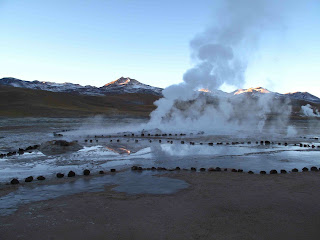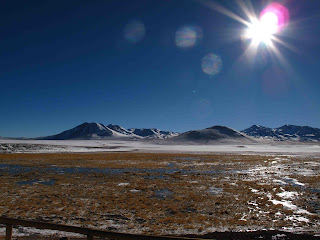We spent two days in Arequipa. We both really liked the city, with it's art deco archtecture and backdrop of snow-capped volcanoes. We took a tour of the cathedral; on the roof we were told how the bell tower fell through the roof during an earthquake in 2001, but was hastily rebuilt - a lesson for Christchurch perhaps?
From Arequipa we got an overnight bus with Cruz del Sur to Cusco. By far the best bus we've ever been on. It was more like a flight, complete with departure lounge and airline food. And it felt like we had got to another country, although we hadn't left Peru. The barren deserts we replaced with green, terraced hills, and the western clothes of Arequipa replaced with colourful traditional Andean garments; even well-dressed businessmen have one token alpaca poncho or scarf. We arrived the day before the annual Inti Raymi Festival, an Inca festival to mark the winter solstice, and today was the main event. It was great to join the thousands of people in the walk up from town to the Inca ruins of Saqsayhuaman (pronounced 'sexy woman'). We braved the crouds on any vantage point to get a glimpse of the proceedings - rows of people dressed in Inca clothes doing a kind of swaying dance to pipes and drums. The small pleasures of life still remain, with the great excitement of collecting our clean laundry. One pays for the laundering service by weight - that is the dirty weight!
On Wednesday we start the Salkantay Trek, a five day trip crossing the 4600m Salkantay Pass and ending at Machu Picchu. More on that next time...
Us in the main square in Arequipa
The Inca constellations
The Inca constelations explained
Cusco main square at night























